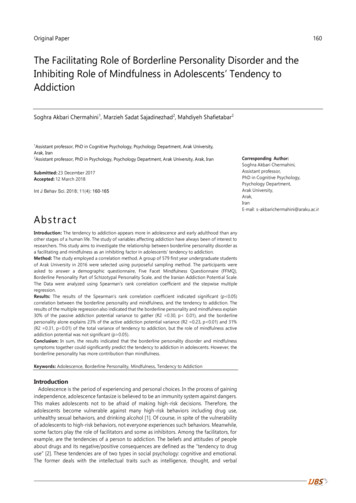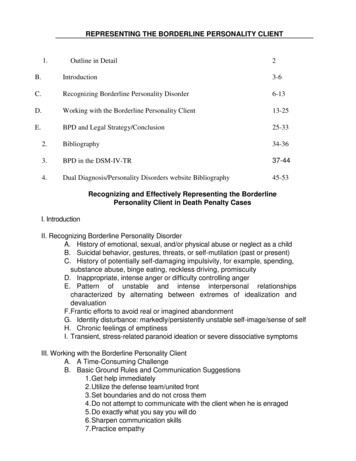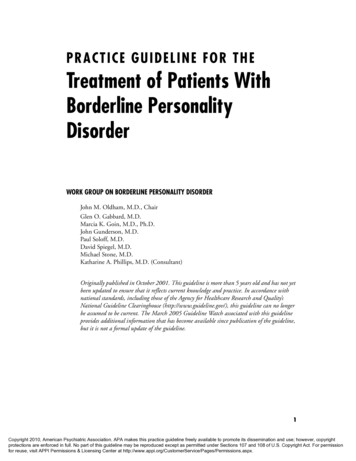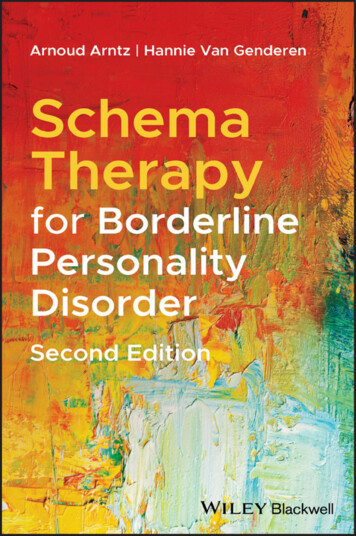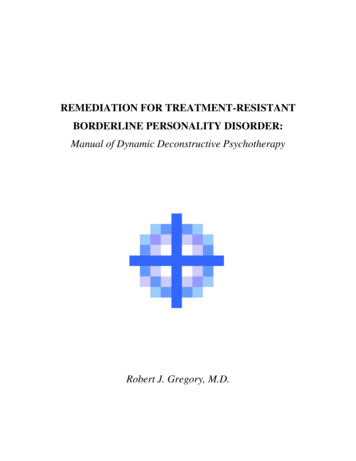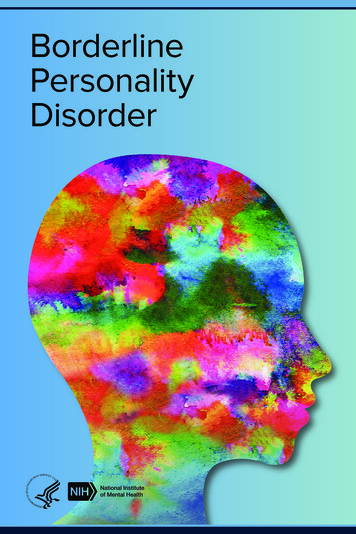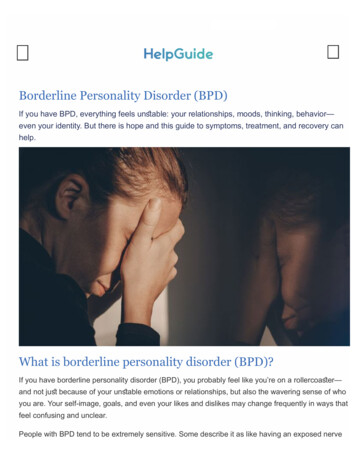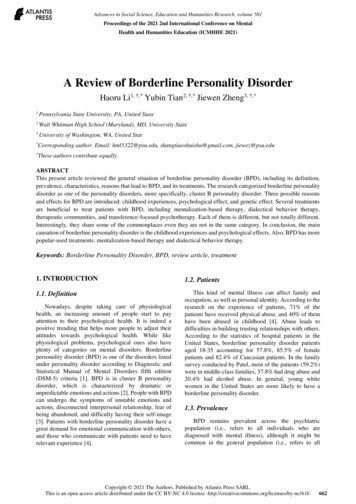
Transcription
Advances in Social Science, Education and Humanities Research, volume 561Proceedings of the 2021 2nd International Conference on MentalHealth and Humanities Education (ICMHHE 2021)A Review of Borderline Personality DisorderHaoru Li1, †,* Yubin Tian2, †,* Jiewen Zheng3, †,*1Pennsylvania State University, PA, United State2Walt Whitman High School (Maryland), MD, University State3University of Washington, WA, United Stat*Corresponding author. Email: hml5322@psu.edu, shangtiaoshuishu@gmail.com, jiewez@psu.edu†These authors contribute equally.ABSTRACTThis present article reviewed the general situation of borderline personality disorder (BPD), including its definition,prevalence, characteristics, reasons that lead to BPD, and its treatments. The research categorized borderline personalitydisorder as one of the personality disorders, more specifically, cluster B personality disorder. Three possible reasonsand effects for BPD are introduced: childhood experiences, psychological effect, and genetic effect. Several treatmentsare beneficial to treat patients with BPD, including mentalization-based therapy, dialectical behavior therapy,therapeutic communities, and transference-focused psychotherapy. Each of them is different, but not totally different.Interestingly, they share some of the commonplaces even they are not in the same category. In conclusion, the maincausation of borderline personality disorder is the childhood experiences and psychological effects. Also, BPD has morepopular-used treatments: mentalization-based therapy and dialectical behavior therapy.Keywords: Borderline Personality Disorder, BPD, review article, treatment1. INTRODUCTION1.2. Patients1.1. DefinitionThis kind of mental illness can affect family andoccupation, as well as personal identity. According to theresearch on the experience of patients, 71% of thepatients have received physical abuse, and 40% of themhave been abused in childhood [4]. Abuse leads todifficulties in building trusting relationships with others.According to the statistics of hospital patients in theUnited States, borderline personality disorder patientsaged 18-35 accounting for 57.8%, 85.5% of femalepatients and 82.4% of Caucasian patients. In the familysurvey conducted by Patel, most of the patients (59.2%)were in middle-class families, 37.8% had drug abuse and20.4% had alcohol abuse. In general, young whitewomen in the United States are more likely to have aborderline personality disorder.Nowadays, despite taking care of physiologicalhealth, an increasing amount of people start to payattention to their psychological health. It is indeed apositive trending that helps more people to adjust theirattitudes towards psychological health. While likephysiological problems, psychological ones also haveplenty of categories on mental disorders. Borderlinepersonality disorder (BPD) is one of the disorders listedunder personality disorder according to Diagnostic andStatistical Manual of Mental Disorders fifth edition(DSM-5) criteria [1]. BPD is in cluster B personalitydisorder, which is characterized by dramatic orunpredictable emotions and actions [2]. People with BPDcan undergo the symptoms of unstable emotions andactions, disconnected interpersonal relationship, fear ofbeing abandoned, and difficulty having their self-image[3]. Patients with borderline personality disorder have agreat demand for emotional communication with others,and those who communicate with patients need to haverelevant experience [4].1.3. PrevalenceBPD remains prevalent across the psychiatricpopulation (i.e., refers to all individuals who arediagnosed with mental illness), although it might becommon in the general population (i.e., refers to allCopyright 2021 The Authors. Published by Atlantis Press SARL.This is an open access article distributed under the CC BY-NC 4.0 license 2
Advances in Social Science, Education and Humanities Research, volume 561individuals without reference of mental illness), thusrepresenting an important public health concern (i.e., amedical issue that affects a significant portion of aspecific population) [6]. It tends to become visible duringearly teenage, worsening as one gets to early adulthood[7]. The prevailing importance of BPD is that the causalto the disease is yet to be established, with variousscholars linking it to genetics, environment, social andcultural factors [8]. The research’s principal objective isto provide evidence on borderline personality disorderbased on its development, particularly using socialbaseline theory and how it can be treated [6].2.2. Psychological EffectsStyles can be applied using the style palette availablewithin the template. To activate it the press Ctrl Shift s.Apply the style as required based on the content andcontext. (Please don’t highlight your text in yellow.)Several psychological factors can lead to borderlinepersonality disorder. Negative childhood experiences areone of the most common reasons that patients get BPD.Reich et al. had convened 358 patients with BPD toconduct a semistructured research interview for thosepatients who have BPD, asking questions about theirchildhood. They were blind to the fact of this researchpurpose. As a result, there are 91% of patients with BPDreported that they have experienced physical abuse and92% of patients were neglected by their parents beforeage of eighteen [11]. Moreover, a borderline personalitydisorder is associated with emotional intelligence.Emotional intelligence is a concept that describes howwell people can control their mood. measured by thetrait-meta mood scale (TMMS). Patients with BPDusually got less scores on their consciousness of emotion[12].2.1. Childhood experience2.3. Genetic EffectsThe study has shown that borderline personalitydisorder may be predicted by observing a specificchildhood state, the main purpose of this study is tocompare the characteristics of children with those adultswith borderline personality disorder [9]. The samecharacteristics of the two are impulsive and emotionalinstability, and so on. According to the research foundthat children with impulsive childhood, emotionalinstability, and other characteristics in adulthood have ahigh risk of suffering from a borderline personalitydisorder. Childhood conditions can be used to predictadult borderline personality disorder, such as impulsive,emotionally unstable [9]. As for the parents of childrenwith borderline personality disorder, the studies foundthat most parents are more sensitive than their children[10]. These parents are disgusted that others talk abouttheir children, and even some parents don't like to hearothers talk about borderline personality disorder. Parentshave a high desire to protect their children [10].The genetic factors form some basis in understandinghow BPD develops. According to Step, first-degreerelatives (i.e., siblings, have BPD at ten times more likelyto have the disorder). While it is evident the disorder runsacross the family no findings are defining the exactamount of the disorder is due to a genetic component.Various twin studies have shown a significant number ofthe disorder attributed to genetic factors estimated at42%, with 58% stemming from other factors. Also,neurological anomalies are found to play an importantrole, the abnormalities can be traced from the confluenceof genetics and past traumatic experiences. Notably,childhood traumatic experiences resulting from a child’sbrain are markedly delicate and still information tends tocontribute significantly to the neural deviation. Byhaving a genetic factor of the disorder, the impact ofthese environmental factors gets amplified to severaldegrees.2. CAUSESBut there are also problems in the above experiment,base on the different age group (the age range of thesubjects was 3-23) the characteristics of borderlinepersonality disorder may be different. This is the defectof the test, because there are uncontrollable factors in thetests, leading to the deviation of the prediction. For theexplanation, the experimenters believe that somecharacteristics only exist in childhood and only stableduring childhood but disappear in adulthood [9].Therefore, the characteristics of childhood can onlybe used as one of the predictive conditions of adultborderline personality disorder, and it cannot becompletely concluded that they will suffer from aborderline personality disorder.3. TREATMENTS3.1. mentalization-based therapy (MBT)There are one of the treatments that are correlatedwith borderline personality disorder: mentalizationbased therapy (MBT) [13]. For MBT, the main part is theprocess of mentalization since BPD includes traits aboutthe problem of relationship and self-image.Mentalization is the process that we can understand eachother and our own according to our subjective state andpsychological process [14]. Although there are a lot ofpsychological disorders that are associated withmisleading thoughts (mostly negative), such as majordepressive disorder and post-traumatic stress disorder(PTSD), it is still worth noticing that therapist should stillfocus on the traits for borderline personality disorder663
Advances in Social Science, Education and Humanities Research, volume 561rather than generally going through the process ofmentalization [14]. The primary target for mentalizationis to help patients start knowing and getting aware ofthemselves, including their inner status, emotions,thoughts, and actions.The therapist's psychotherapeutic attitude shouldinclude five characteristics. First is the humilitystemming from "do not know". The second is to take thetime to identify differences of opinions patiently. Third,accepting different points of view is important. Fourth,ask the patient about his/her experience actively. It iscrucial to ask for a detailed description of the experience"WHAT" rather than an explanation of "WHY". Fifth isto carefully avoid the need to understand what doesn'tmake sense. It is also essential to maintain a greatrelationship between clinicians and patients. Wheninterpreting the result of mentalization, it is crucial tofollow the following six steps. The first is to establishempathy, which is to establish the patient's perspective.This is not the same as agreeing with the patient in anycircumstances, but the patient must be shown that thetherapist has at least understood his or her perspective.The second step is to explore the event that produced thetransference. Actions related to thoughts or emotionsrequire explicit expression and sometimes detail. Thethird is to accept and understand the formulation of thetherapist since it is likely that most of the patient'sexperience in the transference process is based on reality,even if it is partially connected to reality. The fourth stepis to try best to interpret patients. The therapist mustimagine sitting side by side with the patient, rather thanthe opposite. They sit side by side and observe what thepatient is thinking and feeling and try to be as curious aspossible. The fifth is to get the therapist to come up withdiverse points of view, and the last step is to supervisethe patient and their own reactions to them [14].3.2. Dialectical Behavior Therapy (DBT)Generally, Dialectical Behavior Therapy (DBT)represents an approach initially developed by apsychologist, Linehan Marsha, to assist individuals inelevating their cognitive and emotional regulation [15].It is achieved by familiarizing with triggers that stimulatethe reactive states and necessitate identifying andapplying better skills to help manage such sequences offeelings, behaviors, and thoughts, hence avoidingharmful reactions. In persons with borderline personalitydisorder, DBT focuses on involving them in a group orindividual therapy basing on the fact that they areemotionally vulnerable [16]. DBT achieves the treatmentof such individuals by helping them regulate theiremotions, teaching about distress tolerance, andenhancing interpersonal effectiveness and mindfulness.DBT helps treat borderline personality disorder byhelping the affected individuals achieve mindfulness andinterpersonal effectiveness by participating in activitiessuch as group works. Mindfulness and interpersonaleffectiveness are critical due to their ability to inflictpositive behavior change [16]. During the involvement inthe respective group discussions, the participatingmembers formulate a topic that greatly moves theaffected individual. The individuals can also beencouraged to suggest their topics of interest, whichencourages their efficient participation. During suchtimes, they are encouraged to observe and describe theircontent-wise about the topic, and through this, theydevelop core interpersonal and mindful skills, whichhelps manage their moods.Borderline personality disorder can also be treatedthrough DBT practices that involve distress tolerance andemotion regulation. At this point, the core principle ofDBT is to help the patients with the disorder learn howto bear the pain involving unstable mood in a skillfulway. The DBT therapist equips the affected individualswith knowledge on how to overcome their condition byteaching survival techniques such as self-soothing,distraction, thinking about the cons and pros of stayingin such a condition, and how to improve their moments[17]. Vulnerability to an emotional mind can be reducedthrough the patients being encouraged to accept that theiremotions are acceptable, valid, and real. It helps themrealize that other people understand how they feel; hencethe acceptance regulates their emotions.Additionally, DBT can also be essential inminimizing the severity of borderline personalitydisorder by utilizing mindfulness to achieve emotionalregulation simultaneously. During this time, patients areequipped with skills of understanding emotions andidentifying their activities, including behaviors, physicalsensations, and cognition [15]. Through the process,understanding the emotional dynamics and how theygenerally occur also equips the patients with skills ofevaluating and identifying their emotions. The patient’ssuccess in identifying and evaluating their emotions aswell is critical since it acts as a precursor to emotionalregulation.3.3. Schema-Focused TherapySchema-focused therapy refers to a strategy used byhealth professionals to help people with borderlinepersonality disorder identify the behavior patterns andthoughts responsible for their condition’s occurrence.The therapy came into existence in the 1980s after DrYoung realized that cognitive-behavioral therapy, themajor therapy used for the treatment of the condition,was turning obsolete on the victims with chroniccharacter logical issues [18]. The whole therapy focuseson meeting the patient’s unmet emotional needs duringchildhood, from which better relationships are learnedand nurtured to aid recovery.664
Advances in Social Science, Education and Humanities Research, volume 561Firstly, the therapy may employ using imagery,which encourages the patients to re-think memoriesduring their early life. It helps equip with knowledge onmaladaptive schema development. The borderlinepatients are induced to reflect the sensations, includingsounds and sights, in such memories. They areprogressively encouraged to undertake imaginarydialogues with people who appeared around them in suchmemories and encouraged to plead for the unmet needs.The scenario creates an interconnection with their currentfeeling, which produces similar sensations, henceimproving their mood through the elicited met needs[18].Secondly, the therapy may take the strategy ofsoliciting the patients to acquire diaries on anyexperiences responsible for the initial maladaptiveschemas and the corresponding thinking patterns. Duringthe real sessions with the therapists, the patients canrelate the earlier Schema’s thinking patterns from whichthey can make a comparison and relate with theirassociated current behaviors and feelings. The wholeactivity necessitates satisfying emotional needs thatcorrespond to an individual’s mood improvement [18].Finally, schema therapy can also be used to controland manage individuals with a borderline personalitydisorder by deploying a chair work strategy for treatmentpurposes. Chair-work strategy necessitates helping theaffected individuals recognize variations occurring intheir personality and emotions. During such sessions, thetherapist arranges two chairs in an opposite position inwhich the patients under therapy coordinate theirmovements between them simultaneously. While in eachchair, the patients express varying personality aspectsand emotions, both current and past. Additionally, thepatients can involve in an imaginative dialogue with theirfriends, family, or relatives. In such an event, theyexpress their emotional aspects and needs in a singlechair and move to the opposite chair and answerthemselves as an imaginative individual who can meetsuch needs. Positivity resulting from the event helpsimprove emotions and mood [19].3.4. Transference-focused Psychotherapy(TFP)Transference-focused psychotherapy (TFP) requiresthe therapist to treat the patient face-to-face (online faceto-face can also work). The therapist guides the patient tofind out the problem by communicating with the patient[20]. Transference-focused psychotherapy is a long-termtreatment, patients need to meet the therapist at leasttwice a week, and the treatment time is decided accordingto the treatment situation. Studies have shown thatpatients with borderline personality disorder improve alot through transference-focused psychotherapy [20].Transference-focused psychotherapy can improve thecondition of patients with borderline personality disorderby controlling their emotions. In clinical trials, the antidorsal anterior cingulate cortex (ACC) is considered toregulate the expression of emotion and behavior, andtransference-focused psychotherapy can increase theparticipation of anti-dorsal ACC to achieve the effect ofemotion control [21]. In clinical trials, monitoring andrecording the data of patients before, during, and aftertreatment can help to control the patients' emotions.Clinicians analyze the patient's condition through thedata and need to pay attention to the impulsive andirritable emotion of the patient [21]. The role oftransference-focused psychotherapy is to reduce theimpulse of patients, to reduce the symptom of borderlinepersonality disorder.Transfer-focused psychotherapy can be divided intothree parts: early treatment, mid-treatment, and latetreatment. In the experiment, according to the treatmentstatus of patients with borderline personality disorder, wefound that the effect of transfer-focused psychotherapyon patients with early treatment was more effective thanthat of patients with late treatment. In clinical trials, byrecording the emotional status of patients with borderlinepersonality disorder, it was found that the effect wouldchange in the treatment because of patients' ychotherapy for some patients is not an effectivetreatment. Clinicians found that changing the period oftreatment and conversation skills of transfer-focusedpsychotherapy can change the effect of the treatment. Ingeneral, we can find out the difference through therecorded data of patients with borderline personalitydisorder and change the method of transfer-focusedpsychotherapy according to the situation of patients. Inthis way, transfer-focused psychotherapy will play aneffective role in the treatment of borderline personalitydisorder [22].4. CONCLUSIONAs a mental disease, borderline personality disorderhas an impact on the life and communication of patients.Impulsivity, irritability, and other emotional problemsare the manifestations of borderline personality disorder.The present research has studied the pathogenesis andtreatment of borderline personality disorder and foundthat borderline personality disorder can be formed inchildhood, and this kind of mental disease can even betransmitted by the gene. This is an important finding inthe understanding of the severity of borderlinepersonality disorder, incorrect treatment can affectpatients and future generations. The current studiesmainly focus on the treatment of borderline personalitydisorder, and future research should be devoted to thedevelopment of the prevention of borderline personalitydisorder in childhood. Overall, borderline personalitydisorder needs more attention from society to reducesocial prejudice against mental illness.665
Advances in Social Science, Education and Humanities Research, volume 561REFERENCES[1] American Psychiatric Association. (2013).Diagnostic and statistical manual of mentaldisorders (DSM-5 ). American Psychiatric Pub.[2]Bender, D. S., Farber, B. A., & Geller, J. D. (2001).Cluster B personality traits and attachment. Journalof the American Academy of psychoanalysis andDynamic Psychiatry, 29(4), 551-563.[3]Leichsenring, F., Leibing, E., Kruse, J., New, A. S., &Leweke, F. (2011). Borderline personality disorder.The Lancet, 377(9759), 74-84.[4] Ma, W. F., Shih, F. J., Hsiao, S. M., Shih, S. N., &Hayter, M. (2009). 'Caring Across Thorns'–Different care outcomes for borderline personalitydisorder patients in Taiwan. Journal of ClinicalNursing, 18(3), 440-450.[5] Patel, R. S., Manikkara, G., & Chopra, A. (2019).Bipolar disorder and comorbid borderlinepersonality disorder: patient characteristics andoutcomes in US hospitals. Medicina, 55(1), 13.[6] Gonzalez-Torres, M. A. (2018). tydisorders. Current developments and challengesahead. BJPsych international, 15(1), 12-14.[7] Stepp, S. D. (2012). Development of borderlinepersonality disorder in adolescence and youngadulthood: Introduction to the special section.Journal of abnormal child psychology, 40(1), 1-5.[8] Kverme, B., Natvik, E., Veseth, M., & Moltu, C.(2019). Moving toward connectedness–a qualitativestudy of recovery processes for people withborderline personality disorder. Frontiers inpsychology, 10, 430.[9] Cramer, P. (2016). Childhood precursors of adultborderline personality disorder features: alongitudinal study. The Journal of nervous andmental disease, 204(7), 494-499.[10] Boucher, M. È., Pugliese, J., Allard‐Chapais, C.,Lecours, S., Ahoundova, L., Chouinard, R., &Gaham, S. (2017). Parent–child relationshipassociated with the development of borderlinepersonality disorder: a systematic review.Personality and mental health, 11(4), 229-255.clarity, and repair: Exploring emotional intelligenceusing the Trait Meta-Mood Scale.[13] Choi-Kain, L. W., Finch, E. F., Masland, S. R.,Jenkins, J. A., & Unruh, B. T. (2017). What worksin the treatment of borderline personality disorder.Current behavioral neuroscience reports, 4(1), 2130.[14] Bateman, A., & Fonagy, P. (2010). Mentalizationbased treatment for borderline personality disorder.World psychiatry, 9(1), 11.[15] Bedics, J. (2020). The Handbook of DialecticalBehavior Therapy (1st ed., p. XV-30). London:Academic Press.[16] Paris, J. (2008). Borderline personality disorder.New York: Guilford Press.[17] Sperry, L. Handbook of the diagnosis and treatmentof DSM-5 personality disorders (3red.). New York:Routledge.[18] Arntz, A., & Van Genderen, H. (2009). SchemaTherapy for Borderline Personality Disorder (1sted., pp. 7-91). Chichester: John Wiley & Sons.[19] Pugh, M. (2020). Cognitive-behavioral chair work.New York: Routledge.[20] Kernberg, O. F., Yeomans, F. E., Clarkin, J. F., &Levy, K. N. (2008). Transference focusedpsychotherapy: Overview and update. TheInternational Journal of Psychoanalysis, 89(3), 601620.[21] Perez, D. L., Vago, D. R., Pan, H., Root, J.,Tuescher, O., Fuchs, B. H., & Stern, E. (2016).Frontolimbic neural circuit changes in emotionalprocessing and inhibitory control associated withclinical improvement following transference‐focused psychotherapy in borderline personalitydisorder. Psychiatry and clinical neurosciences,70(1), 51-61.[22] Spinhoven, P., Giesen-Bloo, J., van Dyck, R.,Kooiman, K., & Arntz, A. (2007). The therapeuticalliance in schema-focused therapy andtransference-focused psychotherapy for borderlinepersonality disorder. Journal of consulting andclinical psychology, 75(1), 104.[11] Reich, R. B., Vera, S. C., Marino, M. F., Levin, A.,Yong, L., & Frankenburg, F. R. (1997). Reportedpathological childhood experiences associated withthe development of borderline personality disorder.American Journal of Psychiatry, 154(8), 11011106.[12] Salovey, P., Mayer, J. D., Goldman, S. L., Turvey,C., & Palfai, T. P. (1995). Emotional attention,666
borderline personality disorder, and it cannot be completely misleadingconcluded that they will suffer from a borderline personality disorder. 2.2. Psychological Effects Several psychological factors can lead to borderline personality disorder. Negative childhood experiences are one of the most common reasons that patients get BPD.
